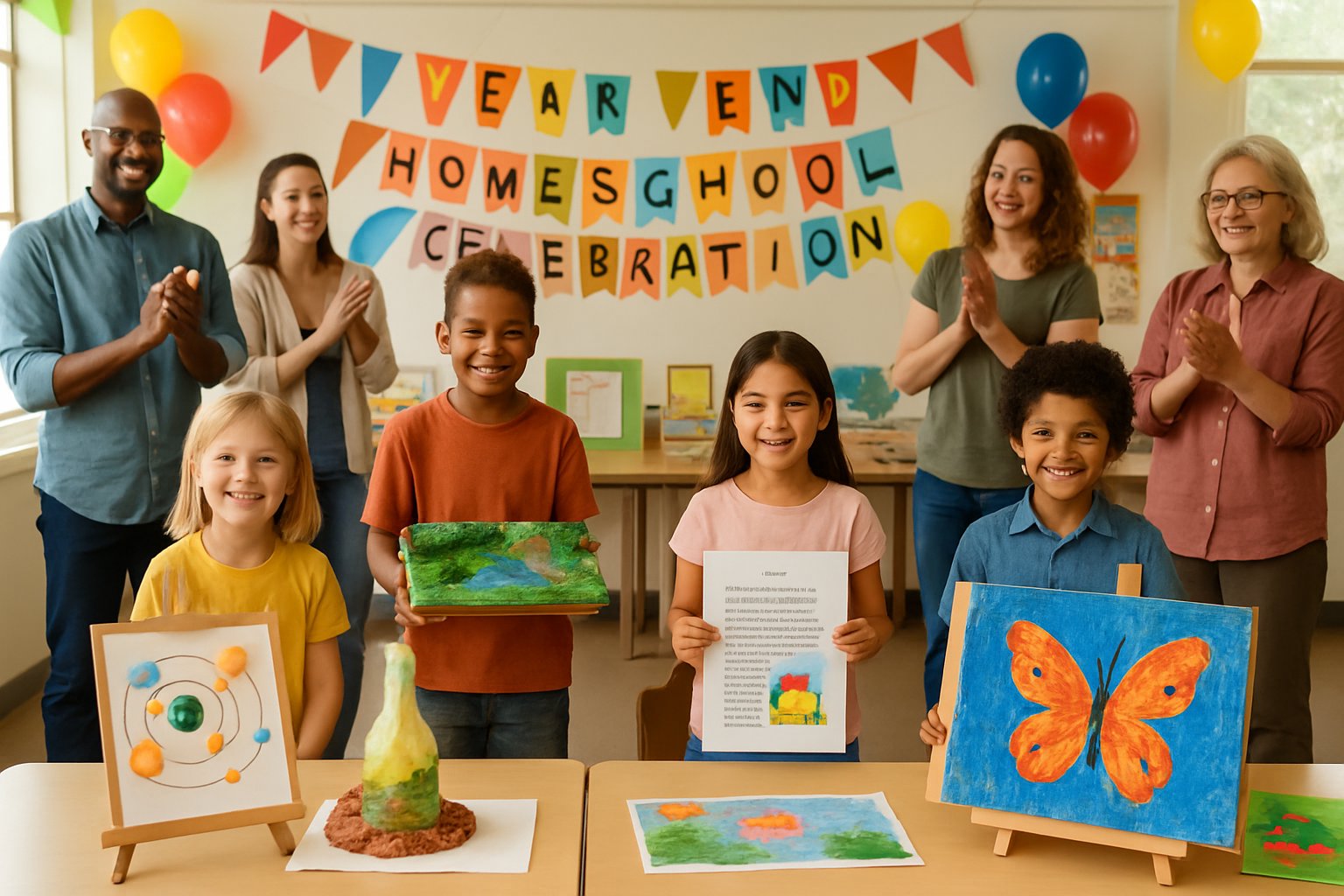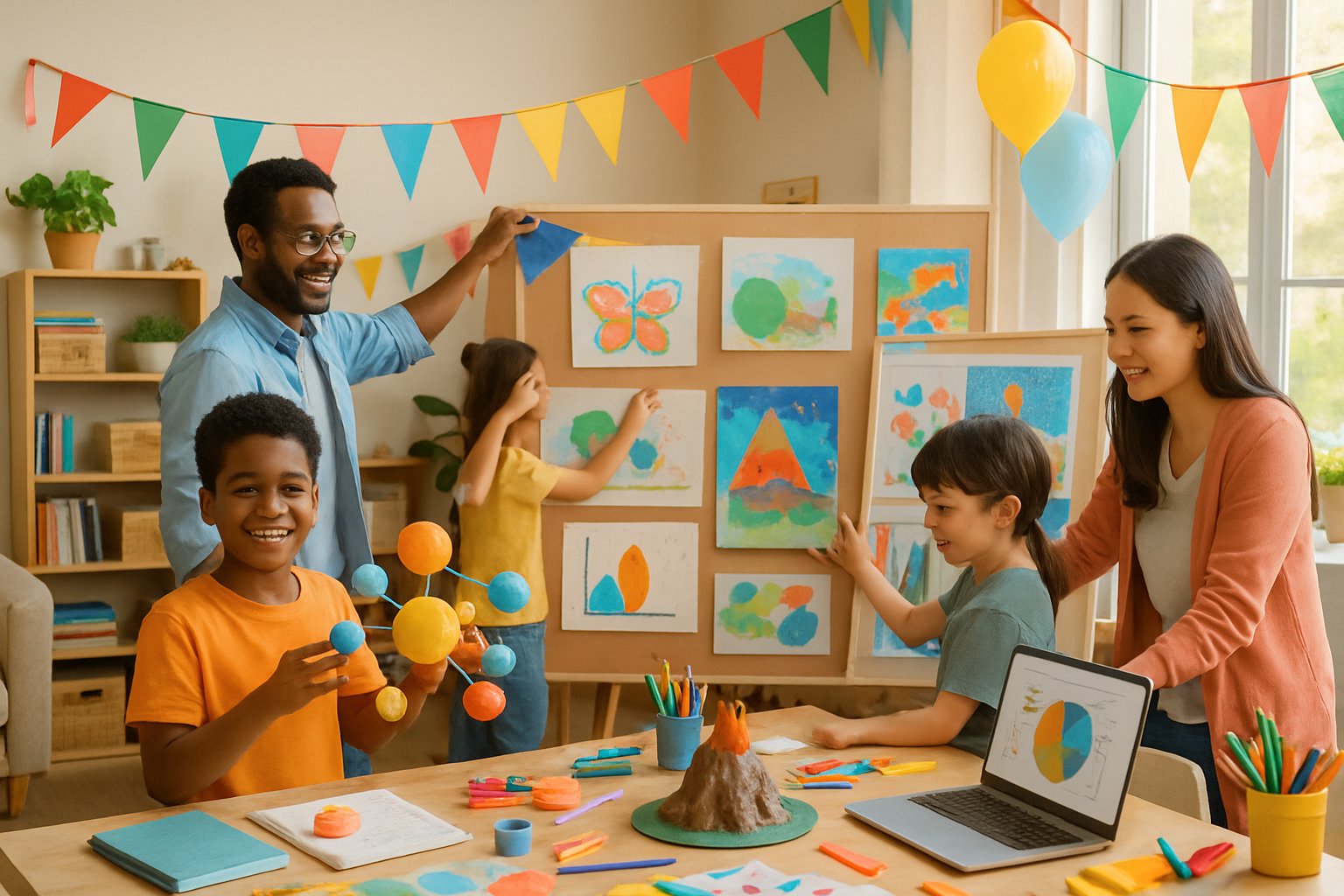Purpose and Benefits of a Year-End Homeschool Showcase

A year-end homeschool showcase gives families a chance to highlight student growth, share meaningful learning with loved ones, and take time to reflect on the year’s progress. It adds value to the homeschool experience by combining celebration, connection, and thoughtful review.
Celebrating Student Progress and Achievements
A showcase allows students to display their best work from across subjects. They might present essays, science projects, art pieces, or math problem sets. Parents can include both early and recent assignments to show progress over time. This makes growth visible in a way that daily lessons sometimes do not.
Many families also display books read during the year. Seeing a stack of completed titles from a homeschool curriculum can be very motivating. Some families even prepare small presentations, such as reciting a poem, playing music, or giving a short talk about a favorite project.
Simple certificates or awards can add a sense of accomplishment. These do not need to be formal; even a homemade “Most Improved Reader” award can encourage pride. The key is to keep the focus on effort and learning rather than comparison.
Building Community and Family Connections
Inviting grandparents, friends, or other homeschool families helps build community. A showcase creates a natural way for children to explain their work and answer questions, which strengthens communication skills. It also gives extended family a clearer picture of the homeschool journey.
Some families host a small gathering at home with snacks and displays on the wall. Others plan a larger event with multiple families sharing projects together. A homeschool showcase can be as simple or as detailed as each family chooses, but the shared experience often becomes a tradition.
These gatherings also support parents. Seeing the year’s accomplishments laid out in one place can reduce feelings of doubt. It reminds them that steady, daily lessons add up to meaningful results.
Reflecting on the Homeschool Journey
A showcase is not only about showing work but also about reflection. Parents and students can look back at goals, assessments, and challenges to see what worked well and what might change for the next year.
Some families create a short portfolio with samples of writing, math tests, and artwork. This provides a record for personal use or for meeting state homeschool requirements. It also helps parents evaluate whether the homeschool curriculum met their child’s needs.
Reflection can also include making lists of skills gained, favorite subjects, or new interests that developed. This process helps children see learning as a journey, not just a task. It encourages them to take ownership of their education and look forward to what comes next.
Planning the Showcase or Celebration

Families benefit from clear goals, practical planning, and shared responsibilities when preparing a homeschool showcase. A well-structured event gives students a chance to highlight their lessons, projects, and growth while making the day enjoyable for everyone.
Setting Goals and Choosing a Theme
Parents and students should first decide what they want the event to highlight. Some may focus on academic subjects like math, science, or history, while others may include art, music, or life skills. Setting goals helps guide decisions about displays, performances, and activities.
A theme can make the event more engaging. For example, a history-focused showcase might feature timelines, costumes, or reenactments, while a science theme could include experiments or models. A theme also helps unify the projects and presentations.
Students can select their favorite lessons or projects to display. This could be a completed writing piece, a science experiment, or a history diorama. Choosing meaningful work gives them ownership and pride in what they present. Parents can encourage variety so that different ages and skill levels are represented.
Themes can also extend into decorations, programs, or even food. A medieval theme might include banners and bread, while a nature theme could use plants or outdoor settings. Keeping the theme simple ensures it adds fun without creating extra stress.
Selecting a Date and Venue
Picking a date early makes planning easier. Families should consider the end of the homeschool year, testing schedules, and holidays. Many groups hold events in late spring when students have finished most lessons.
The venue should match the size and type of activities planned. A living room may work for a small family showcase, while a church hall or library meeting room may be better for larger groups. Some families even use outdoor spaces like parks for casual celebrations.
Accessibility matters. Parents should think about parking, seating, and whether the space allows for both displays and performances. For example, this homeschool celebration guide suggests using separate areas for tables and a stage area for presentations.
It also helps to plan for food and fellowship. A potluck meal or dessert table gives families time to connect and relax after the formal part of the event.
Organizing Volunteers and Roles
Even small events run more smoothly when responsibilities are shared. Parents can assign roles like communication, setup, cleanup, and food coordination. Larger events may also benefit from an emcee to introduce performances and keep the schedule on track.
A simple list of roles might include:
- Communication lead – sends reminders and updates
- Food coordinator – manages potluck sign-ups and supplies
- Setup team – arranges tables and chairs
- Cleanup crew – restores the space afterward
- Emcee – guides the program
Regular reminders help keep families on track. Weekly updates during planning and daily notes in the final week work well. This approach is suggested in practical homeschool planning tips.
Children can also take part in preparation. Older students might help with setup or program design, while younger children can create signs or decorations. Involving students makes the event feel like a true family and community effort.
Showcasing Student Work and Accomplishments
Families can make a homeschool celebration meaningful by giving students a chance to display what they learned, share personal interests, and reflect on progress. Displays, performances, and simple records of growth help highlight both academic subjects and creative projects in a clear and encouraging way.
Displaying Projects and Portfolios
Students often enjoy showing work that represents their effort over the year. A portfolio can include writing samples, math worksheets, art pieces, or science experiments. Parents may organize these in binders or folders so visitors can flip through them easily.
For visual impact, families can hang posters, mount drawings, or set up tri-fold boards. Younger children might display favorite picture books, while older students can share essays or research papers.
A simple table works well for showcasing projects. For example:
| Grade Level | Project Type | Display Idea |
|---|---|---|
| Early Years | Art & Reading | Picture books with hand-drawn covers |
| Middle School | Science | Lab reports with photos of experiments |
| High School | History | Timelines or themed presentations |
This approach allows every student, regardless of age, to present something meaningful.
Highlighting Subjects and Special Interests
A showcase does not need to focus only on traditional subjects. Students can also share hobbies or unique skills. For example, one child may perform music, while another presents a Lego build or sewing project.
Families can encourage children to connect their homeschool curriculum to personal interests. A student studying U.S. history might create a state project, while another interested in animals could prepare a display about pet care.
Performances add variety. These could include dance routines, reciting poetry, or demonstrating a skill. Events like an end-of-year homeschool celebration often combine displays with short presentations, giving students a chance to speak about what they learned.
This balance between academics and personal passions helps students feel proud of both schoolwork and extracurricular growth.
Incorporating Assessments and Progress Reports
While creative displays are engaging, many families also want to highlight academic progress. Simple assessments, such as reading level charts, math fact fluency sheets, or writing samples from the beginning and end of the year, can show clear growth.
Some parents prepare a short progress report. This may include:
- Subjects studied (math, science, language arts, history)
- Skills mastered (multiplication, essay writing, lab experiments)
- Areas for growth (spelling, handwriting, test-taking)
Students can also reflect on their own learning. A child might write a short paragraph about what they enjoyed most or what subject challenged them.
Events like an end-of-year homeschool showcase often encourage families to use these reports alongside displays. This helps parents track learning while giving children a sense of accomplishment.
Creative Activities and Event Ideas
Families can make a homeschool showcase more engaging by mixing academic displays with fun, interactive activities. Students gain confidence when they share what they’ve learned, while families and friends enjoy seeing creativity and effort come to life in different ways.
Hands-On STEAM Challenges and RAFT Projects
STEAM challenges give students a chance to apply science, technology, engineering, art, and math in practical ways. Simple activities, like building a bridge from craft sticks or testing paper airplane designs, encourage problem-solving and teamwork.
RAFT (Resource Area for Teaching) projects are also popular because they combine creativity with core lessons. Students might design a board game to review history facts, write a newspaper article about a science discovery, or create models that explain math concepts.
Parents can set up stations where kids rotate through activities. This keeps energy levels high and ensures everyone has a chance to participate. A display table can also highlight finished RAFT projects so families can see how lessons turned into something tangible.
Student Performances and Presentations
Performances give students a platform to showcase skills beyond written work. Some may sing, play an instrument, or perform a short skit. Others may prefer giving a short talk about a favorite subject, like a science experiment or history project.
A simple schedule helps keep the event smooth. An emcee can introduce each student and keep transitions short. Families who have hosted similar events often include a mix of formal and casual presentations, such as poems, storytelling, or even a Lego robot demonstration.
Students benefit by practicing public speaking in a safe space. Parents and peers learn more about each child’s interests, which makes the event feel personal and meaningful. Examples of past activities, such as student performances and displays, show how flexible this format can be.
Interactive Games and Field Day Events
Adding movement and play keeps kids engaged after sitting through displays or performances. Field day activities like relay races, tug-of-war, or scavenger hunts are easy to organize and appeal to a wide range of ages.
Indoor games can work too. Trivia contests, themed bingo, or review games based on the year’s lessons give students a chance to show knowledge in a relaxed way. Using simple materials like index cards or dice makes setup quick and affordable.
Organizers can divide kids into mixed-age teams. This encourages cooperation and gives older students a chance to guide younger ones. Families may also enjoy joining in, turning the games into a shared experience rather than just a student activity.
Involving Family and Community Members
Family and community involvement adds depth to the event. Parents can contribute by helping with setup, food, or leading small group activities. Grandparents often enjoy attending and may even share stories or skills that connect to lessons.
Inviting community members, such as local artists, librarians, or science club leaders, can bring fresh perspectives. A guest might lead a short workshop, judge a project, or simply attend to encourage students.
Shared meals, like a potluck dinner, also strengthen connections. Many homeschool groups include this tradition, as seen in homeschool celebrations with potlucks. These gatherings give families time to relax and build friendships beyond the structured program.
Leave a Reply